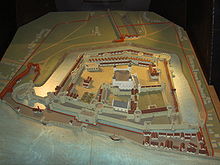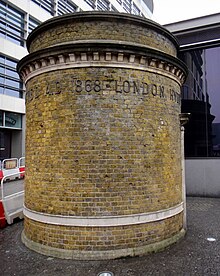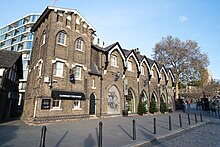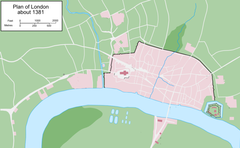Wikipedia
This text was copied from Wikipedia on 20 April 2024 at 6:11AM.


Tower Hill is the area surrounding the Tower of London in the London Borough of Tower Hamlets. It is infamous for the public execution of high status prisoners from the late 14th to the mid 18th century. The execution site on the higher ground north-west of the Tower of London moat is now occupied by Trinity Square Gardens.
Tower Hill rises from the north bank of the River Thames to reach a maximum height of 14.5 metres (48 ft) Ordnance Datum.[1] The land was historically part of the Liberties of the Tower of London, an area the Tower authorities controlled to keep clear of any development which would reduce the defensibility of the Tower. Building has encroached to a degree, but a legacy of this control is that much of the hill is still open. The hill includes land on either side of the London Wall, a large remnant of which is visible.[2]
Definition
Generally speaking, the name Tower Hill informally applies to those parts of the Tower Liberty that are outside the Tower of London and its moat. Great Tower Hill is the land lying inside (or west) of the line of the London Wall whereas Little Tower Hill is the land outside (or east) of the wall.[3]
Public executions


Public executions of high-profile traitors and criminals, often attainted peers, as well as innocent Catholics in the 16th century, were carried out on Tower Hill (some others were carried out within the confines of the Tower of London itself). The backgrounds to those carried out at Tower Hill ranged from the Peasants’ Revolt of 1381 to the Wars of the Roses; Lollardism; claims to the throne by Perkin Warbeck and Lambert Simnel; the English Reformation; the Pilgrimage of Grace; the Monmouth Rebellion; the Jacobite Rising and the Gordon Riots of 1780. Lord Lovat's execution for high treason in 1747 was the last judicial beheading in England while the final executions on Tower Hill were hangings in 1780. Some 120 executions are chronicled and they include:-
- 1381 – Simon Sudbury, Archbishop of Canterbury[4] (beheaded by an angry mob)
- 1381 – Sir Robert Hales[4]
- 1388 – Sir Simon de Burley[4]
- 1388 – John de Beauchamp, 1st Baron Beauchamp (fourth creation)
- 1397 – Richard Fitzalan, 11th Earl of Arundel[4]
- 1440 – Rev. Richard Wyche, Vicar of Deptford[4]
- 1462 – John de Vere, 12th Earl of Oxford[4]
- 1462 – Aubrey de Vere, eldest son and heir of John de Vere, 12th Earl of Oxford
- 1462 – Sir Thomas Tuddenham
- 1462 – William Tyrrell
- 1462 – John Montgomery
- 1470 – John Tiptoft, 1st Earl of Worcester[4]
- 1495 – Sir William Stanley[5]
- 1497 – James Tuchet,[5] a commander of the Cornish Rebellion of 1497
- 1499 – Edward Plantagenet, 17th Earl of Warwick[5]
- 1502 – James Tyrrell
- 1510 – Edmund Dudley
- 1510 – Sir Richard Empson
- 1521 – Edward Stafford, 3rd Duke of Buckingham[5]
- 1535 – John Fisher, Bishop of Rochester[5]
- 1535 – Sir Thomas More,[5] ex-Lord Chancellor
- 1536 – George Boleyn, brother of Anne Boleyn
- 1537 – Thomas Darcy, 1st Baron Darcy de Darcy[5]
- 1538 – Henry Courtenay, Earl of Devon[6]
- 1538 – Edward Neville
- 1539 – Sir Nicholas Carew
- 1539 - Henry Pole, 1st Baron Montagu
- 1540 – Thomas Cromwell, Earl of Essex[6]
- 1540 – Walter Hungerford, 1st Baron Hungerford of Heytesbury[7]
- 1547 – Henry Howard, Earl of Surrey[6]
- 1549 – Thomas Seymour, 1st Baron Seymour of Sudeley
- 1552 – Sir Ralph Vane
- 1552 – Sir Thomas Arundell of Wardour Castle
- 1552 - Sir Michael Stanhope
- 1552 – Edward Seymour, 1st Duke of Somerset[6]
- 1553 - John Dudley, 1st Duke of Northumberland
- 1554 – Sir Thomas Wyatt[6]
- 1554 – Lord Guildford Dudley
- 1554 - Henry Grey, 1st Duke of Suffolk[8]
- 1572 – Thomas Howard, 4th Duke of Norfolk[6]
- 1601 – Sir Christopher Blount
- 1615 – Sir Gervase Helwys
- 1631 – Mervyn Tuchet, 2nd Earl of Castlehaven
- 1641 – Thomas Wentworth, 1st Earl of Strafford[6]
- 1645 – William Laud, Archbishop of Canterbury[9]
- 1651 – Christopher Love, Presbyterian minister
- 1662 – Sir Henry Vane[9]
- 1683 – Col. Algernon Sidney[9]
- 1685 – James Scott, 1st Duke of Monmouth[9]
- 1716 – James Radclyffe, 3rd Earl of Derwentwater[9]
- 1716 - William Gordon, 6th Viscount of Kenmure[10]
- 1746 – William Boyd, 4th Earl of Kilmarnock
- 1746 – Robert Boyd (of Clan Boyd)
- 1746 – Arthur Elphinstone, 6th Lord Balmerino
- 1747 – Simon Fraser, 11th Lord Lovat[9]
Trinity Square and Gardens
After the abandonment of Tower Hill as a site for public executions, Trinity Square and Gardens were laid out in 1797 by Samuel Wyatt as the setting for Trinity House, completed a year earlier as headquarters of the Corporation of Trinity House.
In the 1880s, a section of the London Underground Circle Line was constructed beneath Trinity Square Gardens. In the first decade of the 20th century small buildings, courts and yards bordering Trinity Square were cleared to make way for the construction of the Port of London Authority headquarters at 10 Trinity Square. Begun in 1912 and completed in 1922, the Grade II* building is now a Four Seasons hotel which opened as such on 26 January 2017.[11]
The Merchant Navy Memorial, First World War section, Grade I-listed, was unveiled by Queen Mary (deputising for her husband, King George V) on 12 December 1928.[12] To avoid overshadowing this, the Grade II* Second World War section is In the form of a sunken garden and was unveiled by HM The Queen on 5 December 1955[13] while that commemorating merchant seamen killed in the 1982 Falklands War was unveiled on 4 September 2005 by the First Sea Lord, Admiral Sir Alan West.
Tower Hill Trust
In October 1933, Reverend P B (“Tubby”) Clayton of All Hallows by the Tower and Dr B R Leftwich published “The Pageant of Tower Hill”, which included the outline of a scheme to improve Tower Hill. In December 1933 the inaugural meeting of the Tower Hill Improvement Fund was held. Lord Wakefield was elected president and launched an appeal at the Guildhall in January 1934.[14]
One of the Trust's first actions was to create a beach on the north bank of the Thames between St Katherine's Steps and the Tower for families from the East End.[14]
In 1937 the Fund became the Tower Hill Improvement Trust and set about purchasing a number of buildings it considered eyesores. These were demolished in order to provide gardens and open public spaces. Among the buildings demolished was the giant Myer's tea warehouse, which stood next to All Hallows and blocked the view of the Tower from the west.[14]
During 2001-2003 the Trust part-financed the refurbishment of Trinity Square Gardens.[14]
In June 2006 the Trust's name was shortened to Tower Hill Trust.[14]
Tower Hill (the street)
The street of Tower Hill, within the London Borough of Tower Hamlets, adjoins the City of London at Byward Street and runs eastwards to Minories and Tower Bridge Approach. It replaced Postern Row in the 1880s and was widened and extended a decade later.[15][16][17] Tower Hill is in the London congestion charge zone from its junction with Minories westwards.
A pedestrian subway links Tower Hill tube station to the boundary of the Tower of London where the remains of the south tower of the medieval postern gate are visible.
Tower Hill Terrace and Tower Vaults
Tower Hill Terrace is the pedestrian way that runs south off Tower Hill to Gloucester Court and also the adjoining paved public space, redeveloped in 2019, atop the Tower Vaults shopping complex.[18] A floor plaque in Tower Vaults commemorates its re-opening in 1991 as the surviving part of the 1864 George Myers built Mazawattee Tea Warehouse, extensively bomb-damaged in Second World War air raids and later demolished.
No. 7 of the original 31 Tower Liberty boundary markers is sited at the bottom of the steps linking Gloucester Court to Tower Hill Terrace and no. 8 is positioned at the base of the circular concrete air duct adjoining Tower Hill.[19]
Bulwark Gate (site of)

Immediately east of the Tower of London Welcome Centre on Great Tower Hill are the buried structural remains of the medieval Bulwark Gate and bastion. The lower half of Tower Hill was enclosed in the late 15th century to protect the western entrance to the Tower of London. The large brick bastion commissioned by Edward IV extended part way up Tower Hill from Tower Dock, but was demolished in 1668.[20]
Tower Subway

Tower Subway is a tunnel under the Thames running from Tower Hill to Vine Lane in Southwark. The round brick-built entrance building near the Tower of London's ticket office was constructed in 1926 by the London Hydraulic Power Company.[21] The year of 1868 visible on the structure refers to the Tower Subway Act of 1868 which authorised the construction of the tunnel.[22]

Former Pump House
The grade II listed former pump house (Tower of London shop) was built in 1863 and designed by the architect Anthony Salvin.[23]
Public transport
London Buses route 15 east to Blackwall and west to Trafalgar Square runs along Tower Hill. Tower Hill tube station is adjacent and Tower Gateway DLR station close by as is Tower Pier for London River Services.
References
- ^ Based on spot heights marked on Ordnance Survey digital map of the area.
- ^ Wheatley, Henry Benjamin; Cunningham, Peter (1891). "Tower Hill". London Past and Present. Vol. 3. London: John Murray. pp. 400–402.
- ^ Map of Early Modern London https://mapoflondon.uvic.ca/LITT7.htm, see also linked Tower Hill entry. Note, the posterngate was a small gate in the City Wall; the foundations survive.
- ^ a b c d e f g Sign at site of the scaffold (2)
- ^ a b c d e f g Sign at site of the scaffold (3)
- ^ a b c d e f g Sign at site of the scaffold (4)
- ^ "Walter Hungerford and the 'Buggery Act' | English Heritage". www.english-heritage.org.uk. Retrieved 20 March 2017.
- ^ "Duke of Suffolk's Monument, Astley | Warwickshire Museum's Take the Timetrail". timetrail.warwickshire.gov.uk/. Retrieved 22 October 2023.
- ^ a b c d e f Sign at site of the scaffold (5)
- ^ "The Scots peerage : Founded on Wood's ed. Of Sir Robert Douglas's Peerage of Scotland; containing an historical and genealogical account of the nobility of that kingdom".
- ^ "City of London, Trinity Square Conservation Area, Draft Character Summary and Management Strategy SPD" (PDF). Democracy: City of London. City of London Corporation. Retrieved 23 November 2021.
- ^ Historic England. "The Merchant Navy Memorial, First World War section (1260087)". National Heritage List for England.
- ^ Historic England. "The Merchant Navy Memorial, Second World War section (1031597)". National Heritage List for England.
- ^ a b c d e "History of the Tower Hill Trust". Tower Hill Trust. Retrieved 19 November 2021.
- ^ Henry A Harben, 'Portpool Lane - Potters' Alley, Court', in A Dictionary of London (London, 1918), British History Online http://www.british-history.ac.uk/no-series/dictionary-of-london/portpool-lane-potters-alley-court [accessed 24 November 2021].
- ^ Henry A Harben, 'Tower Chambers - Traitors' Bridge', in A Dictionary of London (London, 1918), British History Online http://www.british-history.ac.uk/no-series/dictionary-of-london/tower-chambers-traitors-bridge [accessed 24 November 2021].
- ^ Henry A Harben, 'Little Somer's Key - Little Tower Hill', in A Dictionary of London (London, 1918), British History Online http://www.british-history.ac.uk/no-series/dictionary-of-london/little-somers-key-little-tower-hill [accessed 24 November 2021].
- ^ "Tower Hill Terrace". www.architectsjournal.co.uk. EMAP Publishing Limited. Retrieved 25 November 2021.
- ^ Historic England. "HM TOWER OF LONDON LIBERTY BOUNDARY MARKERS (1393922)". National Heritage List for England. Retrieved 26 November 2021.
- ^ Historic England. "Tower Hill West (1001980)". National Heritage List for England. Retrieved 27 November 2021.
- ^ "Tower Subway". www.Subterranea Britannica.org.uk. Subterranea Britannica. Retrieved 27 November 2021.
- ^ Smith, Denis (2001). Civil Engineering Heritage: London & The Thames Valley. Institution of Civil Engineers/Thomas Telford Ltd. p. 22. ISBN 9780727728760.
- ^ Historic England. "FORMER PUMP HOUSE (1357558)". National Heritage List for England. Retrieved 27 November 2021.
External links
 Media related to Tower Hill at Wikimedia Commons
Media related to Tower Hill at Wikimedia Commons- The changing face of Tower Hill as portrayed by old maps






6 Annotations
First Reading
Glyn • Link
Tower Hill was the site of many public executions, usually beheadings, as opposed to more private executions which took place inside the Tower of London.
This is the former execution site on Tower Hill as it currently appears:
http://www.flickr.com/photos/5735…
and
http://www.flickr.com/photos/5735…
Cumgranissalis • Link
great site: thanks
Bradford • Link
Grim edifice, superbly captured. Those of us several thousand miles away thank you.
Second Reading
Terry Foreman • Link
Clockwise from the NW: Tower Hill / Little Tower Hill / Iron Gate / Tower Wharf (1746)
http://www.motco.com/Map/81002/Se…
Bill • Link
Tower hill, a very spacious area to the north, east and west of the Tower ditch, divided into Great and Little Tower hill. The west end extending much farther to the north is called by the former name, and the east end, in which is the victualling office, by the latter. It must be confessed that Tower hill has many handsome buildings, particularly among the row of houses which bound it to the west; but, though this great area might be rendered extremely beautiful, it is quite the reverse, in almost every other part besides that just mentioned, we find it ill built, and the ground a mere dunghill; particularly in little Towerhill, where we see either the backs of the houses next this fine area, or mean edifices in ruins. But as the hill is now improved and rendered more safe by placing strong wooden rails on the outside of the ditch, it is to be hoped that the ground will be completely levelled, and laid out to greater advantage, and that some care will be taken to rebuild the houses that are falling down, particularly as this is a place visited by all strangers.
---London and Its Environs Described. R. Dodsley, 1761.
Third Reading
San Diego Sarah • Link
ON ANY GIVEN DAY, VISITORS to the Tower of London can vary from several hundred to well into the thousands. Many come wanting to see the Crown Jewels, or perhaps they desire to visit the location of where many famous executions took place.
Fewer than 24 people met their maker at the end of the executioner’s axe on Tower Green. They included the 2 wives of Henry VIII (Anne Boleyn, and Catherine Howard), as well as Lady Jane Grey, who was Queen of England for only 9 days.
What they may not be aware of, is that the vast majority of public executions took place outside the walls of the Tower, a few yards away, on a grassy knoll (near Tower Hill Underground Station}.
An estimated 125 people lost their lives across the road on Tower Hill. The disparity in numbers is because executions inside the Tower of London were reserved for individuals of extremely high rank, or who possessed great popular support.
At the western edge of a green space known as Trinity Square Gardens, a scaffold was erected from the 15th century to dispatch individuals who held an air of status and were found guilty of high treason or other offenses against the crown. It operated for nearly 400 years, with the last public execution taking place in 1747, that of Simon Fraser, 11th Lord Lovat, a supporter of the Stuart family’s right to the throne.
Today, visitors can find a small cordoned-off area, just to the left of the Merchant Navy Memorial, WWI Section. Here, you’ll find the list of their names, beginning in 1381 and ending in the mid-1700s. It includes participants in the following rebellions: Peasants’ Revolt, War of the Roses, English Reformation, as well as the Jacobite Uprising. Thousands of eager onlookers would gather to witness these public displays of execution.
Located in Trinity Square Gardens, a few yards west of Tower Hill Underground Station, close to the intersection of Tower Hill and Trinity Square. Always accessible, free of charge.
https://www.atlasobscura.com/plac…
That's the same Tube station you'll use for Seething Lane, St. Olave's and St. Bartholomews Barking